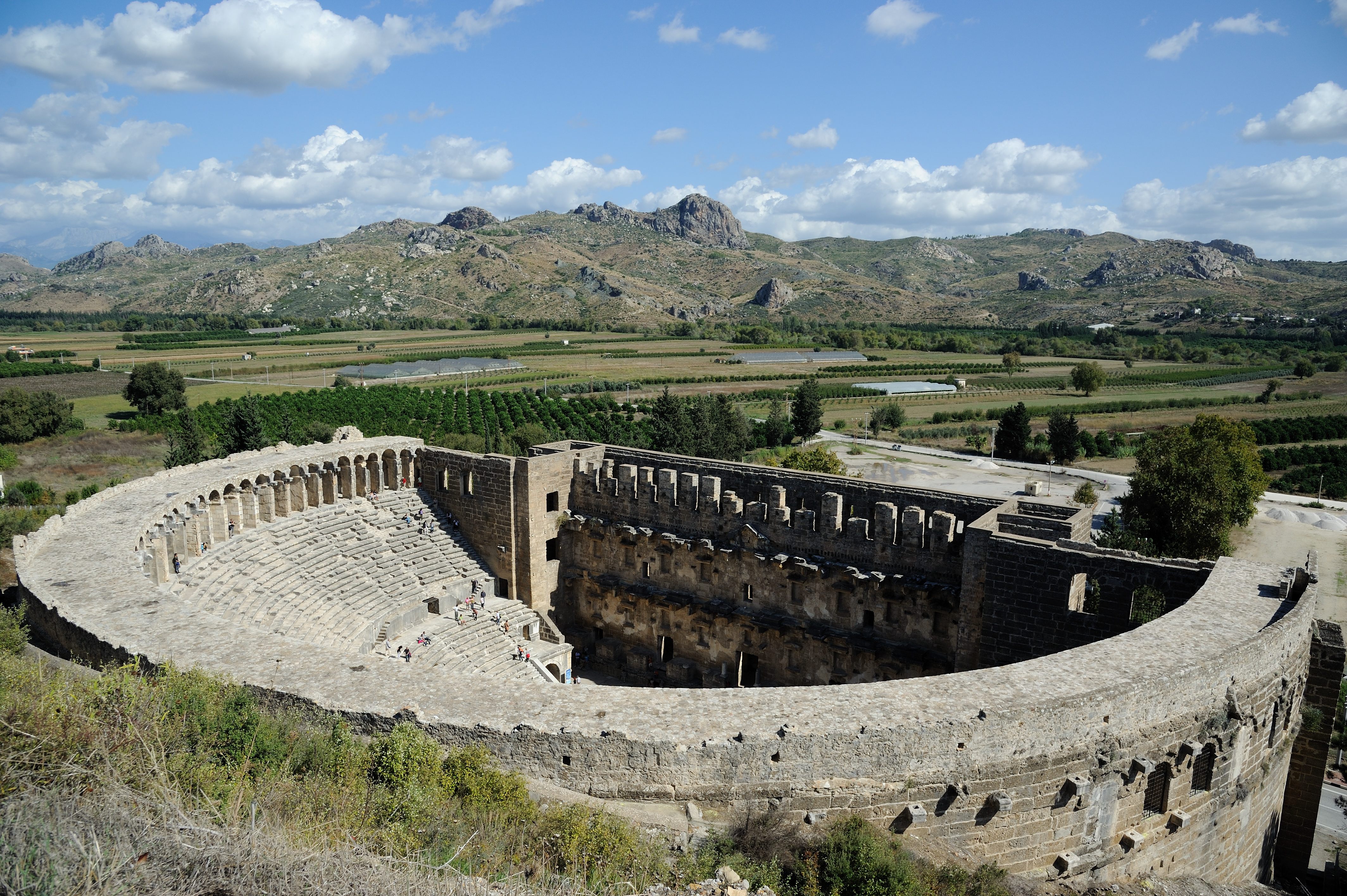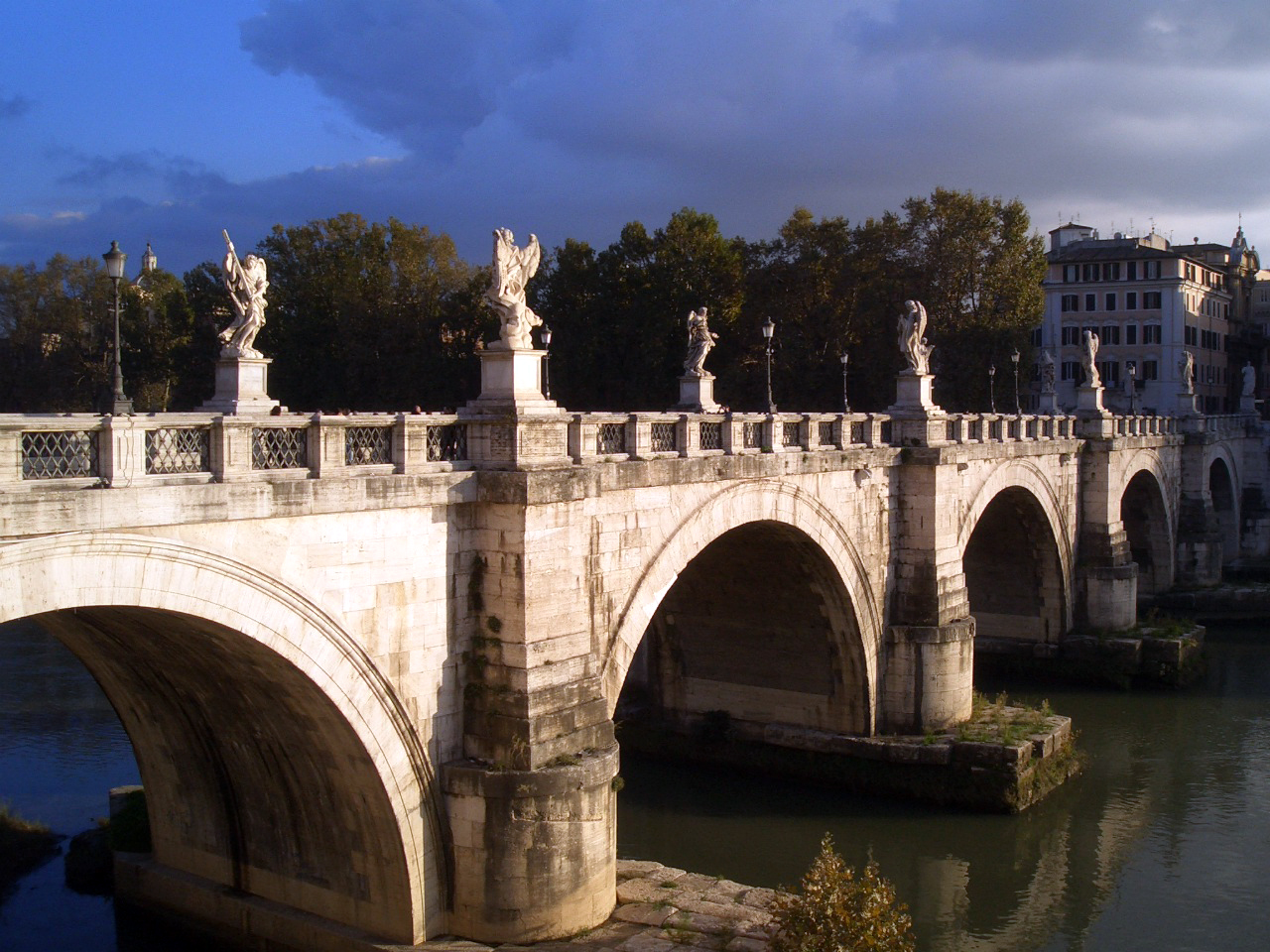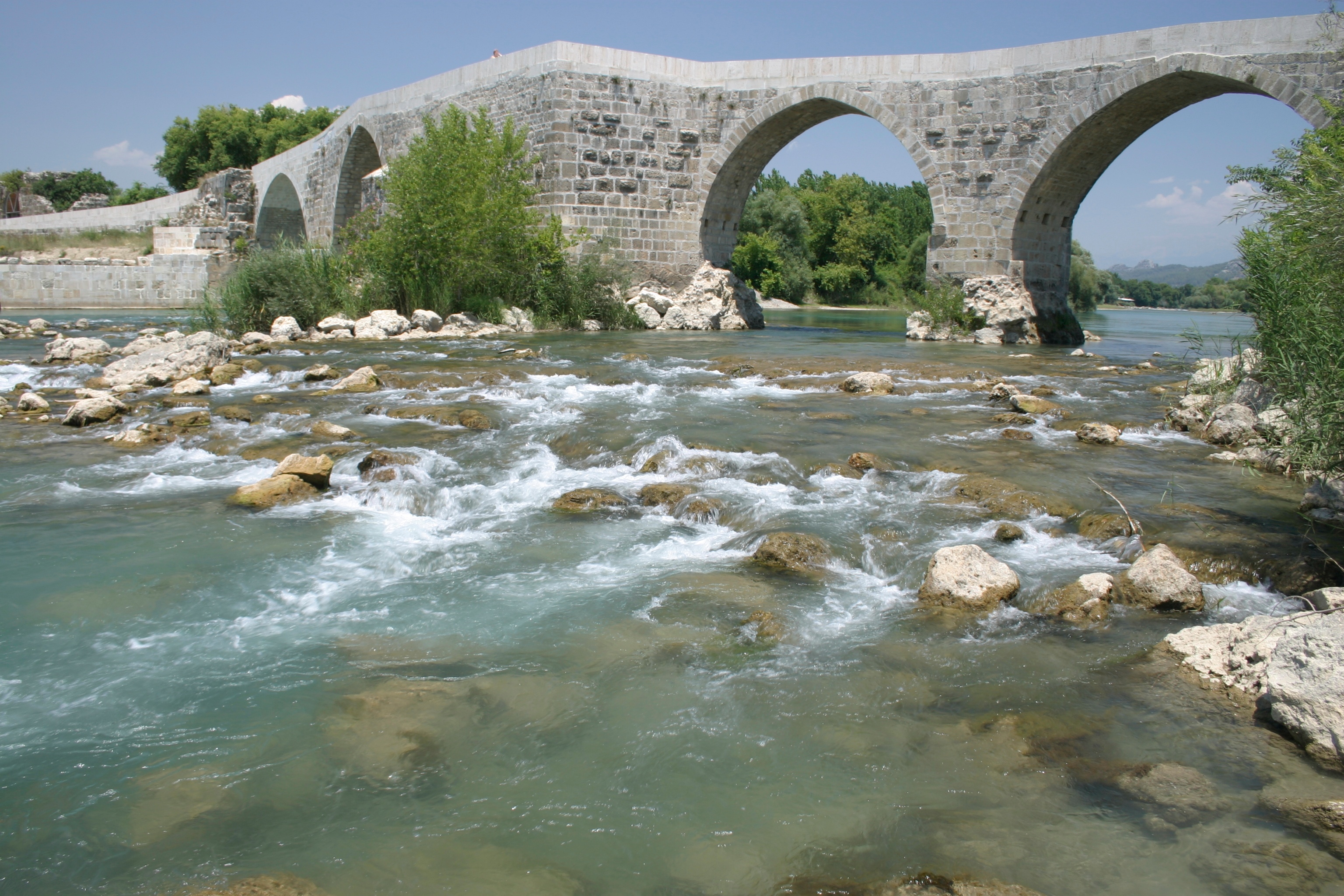|
Eurymedon Bridge (Selge)
The Eurymedon Bridge ( tr, Oluk Köprü) is a Roman bridge over the river Eurymedon (modern Köprüçay River) near Selge in Pisidia in southern Turkey. It is part of the road winding up from the coastal region Pamphylia to the Pisidian hinterland. Located 5 km north of the village Beşkonak in a sparsely settled area, the bridge crosses the Eurymedon high above the valley bottom. The excellently preserved structure is 14 m long and 3.5 m wide (with a roadway of 2.5 m). The clear span of its single arch is c. 7 m, the thickness of its voussoirs, which were set without the use of mortar, 60 cm. The building technique and the sturdy stonework point to a construction date in the 2nd century AD, a time when Selge was flourishing. Forty-two km downstream at Aspendos, the Eurymedon is crossed by another extant old bridge. Gallery File:Eurymedon Bridge 5066.jpg, File:Eurymedon Bridge 5058.jpg, File:Eurymedon Bridge 5051.jpg, File:Köprülü Kanyon ... [...More Info...] [...Related Items...] OR: [Wikipedia] [Google] [Baidu] |
Eurymedon River
Eurymedon may refer to: Historical figures *Eurymedon (strategos) (died 413 BC), one of the Athenian generals (strategoi) during the Peloponnesian War *Eurymedon of Myrrhinus, married Plato's sister, Potone; he was the father of Speusippus * Eurymedon the hierophant, the representative of Eleusinian Demetra; together with the school of Isocrates and Demophilos they brought a charge of impiety against Aristotle Greek mythology *Eurymedon (mythology) Geography *Eurymedon River, now Köprüçay River * Eurymedon Bridge (Aspendos), over this river at Aspendos * Eurymedon Bridge (Selge), over this river at Selge Other uses * 5012 Eurymedon, asteroid *''The Eurymedon'', alternative name for '' New Zealand Shipping Co. Ltd. v. A. M. Satterthwaite & Co. Ltd.'' court case * Eurymedon vase, an Attic red-figure ''oinochoe'', a wine jug attributed to the circle of the Triptolemos Painter made ca. 460 BC, which is now in the ''Museum für Kunst und Gewerbe Hamburg'' (1981.173) See ... [...More Info...] [...Related Items...] OR: [Wikipedia] [Google] [Baidu] |
Aspendos
Aspendos or Aspendus ( Pamphylian: ΕΣΤϜΕΔΥΣ; Attic: Ἄσπενδος) was an ancient Greco-Roman city in Antalya province of Turkey. The site is located 40 km east of the modern city of Antalya. It was situated on the Eurymedon River about 16 km inland from the Mediterranean Sea; it shared a border with, and was hostile to, the ancient city of Side. History The wide range of its coinage throughout the ancient world indicates that, in the 5th century BC, Aspendos had become the most important city in Pamphylia. At that time, according to Thucydides, the Eurymedon River was navigable as far as Aspendos, and the city derived great wealth from a trade in salt, oil and wool. Aspendos did not play an important role in antiquity as a political force. Its political history during the colonisation period corresponded to the currents of the Pamphylian region. Within this trend, after the colonial period, it remained for a time under Lycian hegemony. In 546 ... [...More Info...] [...Related Items...] OR: [Wikipedia] [Google] [Baidu] |
Stone Bridges In Turkey
In geology, rock (or stone) is any naturally occurring solid mass or aggregate of minerals or mineraloid matter. It is categorized by the minerals included, its Chemical compound, chemical composition, and the way in which it is formed. Rocks form the Earth's outer solid layer, the Earth's crust, crust, and most of its interior, except for the liquid Earth's outer core, outer core and pockets of magma in the asthenosphere. The study of rocks involves multiple subdisciplines of geology, including petrology and mineralogy. It may be limited to rocks found on Earth, or it may include planetary geology that studies the rocks of other celestial objects. Rocks are usually grouped into three main groups: igneous rocks, sedimentary rocks and metamorphic rocks. Igneous rocks are formed when magma cools in the Earth's crust, or lava cools on the ground surface or the seabed. Sedimentary rocks are formed by diagenesis and lithification of sediments, which in turn are formed by the weathe ... [...More Info...] [...Related Items...] OR: [Wikipedia] [Google] [Baidu] |
Deck Arch Bridges
Deck may refer to: A level or platform Buildings and structures * Deck (bridge), the roadway surface of a bridge * Deck (building), an outdoor floor attached to a building made of wood or wood-like material *Another name for a storey *The concrete or tile area surrounding a swimming pool *Deck arch bridge, a type of bridge *Observation deck, a platform situated upon a tall architectural structure or natural feature * Orthotropic deck * Roof deck, the framing and sheathing to which roofing material is applied Transportation *Bus deck, referring to the number of passenger levels on a bus *Cockpit A cockpit or flight deck is the area, usually near the front of an aircraft or spacecraft, from which a pilot controls the aircraft. The cockpit of an aircraft contains flight instruments on an instrument panel, and the controls that e ..., also called a "flight deck" Maritime *Deck (ship), a floor of a ship *Flight deck of an aircraft carrier Audiovisual equipment *Cassette ... [...More Info...] [...Related Items...] OR: [Wikipedia] [Google] [Baidu] |
Roman Bridges In Turkey
Roman or Romans most often refers to: *Rome, the capital city of Italy *Ancient Rome, Roman civilization from 8th century BC to 5th century AD *Roman people, the people of ancient Rome *''Epistle to the Romans'', shortened to ''Romans'', a letter in the New Testament of the Christian Bible Roman or Romans may also refer to: Arts and entertainment Music *Romans (band), a Japanese pop group * ''Roman'' (album), by Sound Horizon, 2006 * ''Roman'' (EP), by Teen Top, 2011 *" Roman (My Dear Boy)", a 2004 single by Morning Musume Film and television *Film Roman, an American animation studio * ''Roman'' (film), a 2006 American suspense-horror film * ''Romans'' (2013 film), an Indian Malayalam comedy film * ''Romans'' (2017 film), a British drama film * ''The Romans'' (''Doctor Who''), a serial in British TV series People *Roman (given name), a given name, including a list of people and fictional characters *Roman (surname), including a list of people named Roman or Romans *Ῥωμα� ... [...More Info...] [...Related Items...] OR: [Wikipedia] [Google] [Baidu] |
Roman Engineering
The ancient Romans were famous for their advanced engineering accomplishments. Technology for bringing running water into cities was developed in the east, but transformed by the Romans into a technology inconceivable in Greece. The architecture used in Rome was strongly influenced by Greek and Etruscan sources. Roads Roads were common at that time, but the Romans improved their design and perfected the construction to the extent that many of their roads are still in use today. Their accomplishments surpassed most other civilizations of their time, and after their time, and many of their structures have withstood the test of time to inspire others, especially during the Renaissance. Moreover, their contributions were described in some detail by authors such as Pliny the Elder, so there is a printed record of their many inventions and achievements. Aqueducts A thousand cubic metres (260,000 US gal) of water were brought into Rome by eleven different aqueducts each day. P ... [...More Info...] [...Related Items...] OR: [Wikipedia] [Google] [Baidu] |
Roman Architecture
Ancient Roman architecture adopted the external language of classical Greek architecture for the purposes of the ancient Romans In modern historiography, ancient Rome refers to Roman civilisation from the founding of the city of Rome in the 8th century BC to the collapse of the Western Roman Empire in the 5th century AD. It encompasses the Roman Kingdom (753–509 ..., but was different from Greek buildings, becoming a new architecture, architectural style. The two styles are often considered one body of classical architecture. Roman architecture flourished in the Roman Republic and to even a greater extent under the Roman Empire, Empire, when the great majority of surviving buildings were constructed. It used new materials, particularly Roman concrete, and newer technologies such as the arch and the dome to make buildings that were typically strong and well-engineered. Large numbers remain in some form across the former empire, sometimes complete and still in use to t ... [...More Info...] [...Related Items...] OR: [Wikipedia] [Google] [Baidu] |
List Of Roman Bridges
This is a list of Roman bridges. The Romans were the world's first major bridge builders. The following list constitutes an attempt to list all known surviving remains of Roman bridges. A Roman bridge in the sense of this article includes any of these features: *Roman arches *Roman pillars *Roman foundations *Roman abutments *Roman roadway *Roman cutwaters Also listed are bridges which feature substantially Roman material (spolia), as long as the later bridge is erected on the site of a Roman precursor. Finally, incidences where only inscriptions lay testimony to a former Roman bridge are also included. In the following, bridges are classified either according to their material or their function. Most data not otherwise marked come from O’Connor's ''Roman Bridges'', which lists 330 stone bridges for traffic, 34 timber bridges and 54 aqueduct bridges. An even larger compilation of more than 900 Roman bridges (as of 2011) is offered by the Italian scholar Galliazzo, who is ... [...More Info...] [...Related Items...] OR: [Wikipedia] [Google] [Baidu] |
Eurymedon Bridge (Aspendos)
The Eurymedon Bridge was a late Roman bridge over the river Eurymedon (modern ''Köprüçay''), near Aspendos, in Pamphylia in southern Anatolia. The foundations and other stone blocks (''spolia'') of the Roman structure were used by the Seljuqs to build a replacement bridge in the 13th century, the Köprüpazar Köprüsü, which stands to this day. This bridge is characterized by a significant displacement along its mid-line, noticeable by looking at its ancient piers. Roman bridge Structure The original shape and construction of the Roman-era bridge have been reconstructed digitally, based on the extant remains of the ancient structure: the ramps, the abutments, and foundations of the piers. Several pieces of the original bridge are scattered along the river bed on both banks, and were not used during reconstruction. Originally, the bridge had a length of 259.50 m and a width of 9.44 m, and had nine semicircular arches. It crossed the river at a basic 90-degr ... [...More Info...] [...Related Items...] OR: [Wikipedia] [Google] [Baidu] |
Mortar (masonry)
Mortar is a workable paste which hardens to bind building blocks such as stones, bricks, and concrete masonry units, to fill and seal the irregular gaps between them, spread the weight of them evenly, and sometimes to add decorative colors or patterns to masonry walls. In its broadest sense, mortar includes pitch, asphalt, and soft mud or clay, as those used between mud bricks, as well as cement mortar. The word "mortar" comes from Old French ''mortier'', "builder's mortar, plaster; bowl for mixing." (13c.). Cement mortar becomes hard when it cures, resulting in a rigid aggregate structure; however, the mortar functions as a weaker component than the building blocks and serves as the sacrificial element in the masonry, because mortar is easier and less expensive to repair than the building blocks. Bricklayers typically make mortars using a mixture of sand, a binder, and water. The most common binder since the early 20th century is Portland cement, but the ancient binder l ... [...More Info...] [...Related Items...] OR: [Wikipedia] [Google] [Baidu] |
Selge, Pisidia
Selge ( el, Σέλγη) was an important city in ancient Pisidia and later in Pamphylia, on the southern slope of Mount Taurus, modern Antalya Province, Turkey, at the part where the river Eurymedon River ( tr, Köprüçay) forces its way through the mountains towards the south. History The town was believed to be a Greek colony, for Strabo states that it was founded by Spartans, but adds the somewhat unintelligible remark that previously it had been founded by Calchas. Stephanus of Byzantium at the Ethnica, also, write that the city was a Lacedaemon colony. The acropolis of Selge bore the name of Kesbedion. The district in which the town was situated was extremely fertile, producing abundance of oil and wine, but the town itself was difficult of access, being surrounded by precipices and beds of torrents flowing towards the Eurymedon and Cestrus (today Aksu), and requiring bridges to make them passable. In consequence of its excellent laws and political constitution, Selge rose ... [...More Info...] [...Related Items...] OR: [Wikipedia] [Google] [Baidu] |
Voussoir
A voussoir () is a wedge-shaped element, typically a stone, which is used in building an arch or vault. Although each unit in an arch or vault is a voussoir, two units are of distinct functional importance: the keystone and the springer. The keystone is the centre stone or masonry unit at the apex of an arch. The springer is the lowest voussoir on each side, located where the curve of the arch springs from the vertical support or abutment of the wall or pier. The keystone is often decorated or enlarged. An enlarged and sometimes slightly dropped keystone is often found in Mannerist arches of the 16th century, beginning with the works of Giulio Romano, who also began the fashion for using voussoirs above rectangular openings, rather than a lintel (Palazzo Stati Maccarani, Rome, circa 1522). The word is a stonemason's term borrowed in Middle English from French verbs connoting a "turn" (''OED''). Each wedge-shaped voussoir ''turns aside'' the thrust of the mass above, tr ... [...More Info...] [...Related Items...] OR: [Wikipedia] [Google] [Baidu] |








